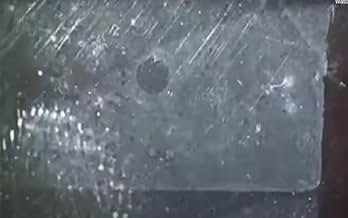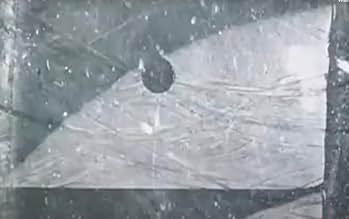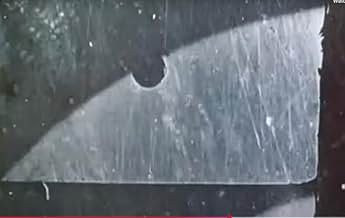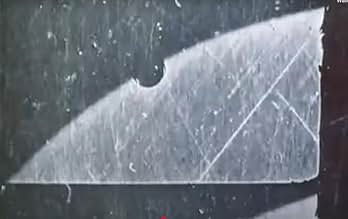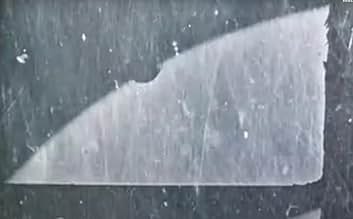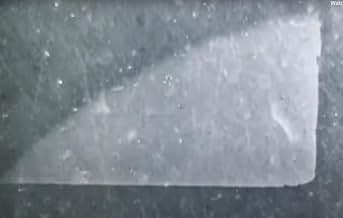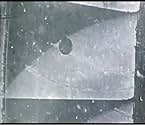Passage de Venus
- 1874
- 1min
VALUTAZIONE IMDb
6,8/10
2413
LA TUA VALUTAZIONE
Cronofotografia primordiale del transito di Venere del 1874, catturata da Jules Janssen in Giappone usando il suo "fucile fotografico" per la ricerca scientifica.Cronofotografia primordiale del transito di Venere del 1874, catturata da Jules Janssen in Giappone usando il suo "fucile fotografico" per la ricerca scientifica.Cronofotografia primordiale del transito di Venere del 1874, catturata da Jules Janssen in Giappone usando il suo "fucile fotografico" per la ricerca scientifica.
- Regia
Recensioni in evidenza
To most this may look simply like a home movie. But it's labeled the first movie ever actually made on IMDb. That's no small accomplishment. This 1-2 second movement of Venus across the sun is not only mentally exciting, but also incredibly groundbreaking. I myself cannot confirm if it's actually Venus going across the sun, but if it is, it also showcases an excellent appearance of space movement, which was still in its relative infancy in photography.
I doubt this was actually filmed frame by frame. They could've most likely just took a few photographs on a standstill camera and wrapped them all together to create the illusion of movement. But hey. Isn't that what stop motion is about? So not only is it the first movie ever, the first movie to show the sun looking good, it's also the first stop motion movie ever made. Isn't that incredible?
I probably would've given this a lower rating if it was newer, but since it's the first of it's kind, I think it's well deserving of a 9.
I doubt this was actually filmed frame by frame. They could've most likely just took a few photographs on a standstill camera and wrapped them all together to create the illusion of movement. But hey. Isn't that what stop motion is about? So not only is it the first movie ever, the first movie to show the sun looking good, it's also the first stop motion movie ever made. Isn't that incredible?
I probably would've given this a lower rating if it was newer, but since it's the first of it's kind, I think it's well deserving of a 9.
How could anyone (besides an idiot) give this short such a low rating? I'm annoyed at what I'm seeing. This is one of the first attempts at making a film, and you idiots give it a 2? A 3? That is really poor on your part. I'll tell you why.
First of all, where do you think today's movies came from? Did cinema evolve out of nowhere? Of course not! Cinema had to progress. People had to get their ideas, experiment, mess around, whatever. You cannot give this such a low rating! Yes, it's a scratchy mess, and impossible to identify what it's about, but you have to start somewhere. So maybe it's not exactly a great film in itself, but still deserves at least a 7.
The guy who gave it a 10 was really thinking about it. He understood. You cannot criticize it for its scratchiness or anything. The fact it is one of the earliest attempts at filmmaking is enough.
I will admit it's not a true film. As IMDb's summary states, it is merely photographs, and is not 'filmed', per say, on a filmstrip. The first true celluloid film was Louis le Prince's "Roundhay Garden Scene" in 1888, but until then this is an important movie suggesting the beginning of our medium. It is also important because the event it portrays is a once-in-a-lifetime experience that we wouldn't be able to witness today. But, thanks to Pierre Janssen, we can.
First of all, where do you think today's movies came from? Did cinema evolve out of nowhere? Of course not! Cinema had to progress. People had to get their ideas, experiment, mess around, whatever. You cannot give this such a low rating! Yes, it's a scratchy mess, and impossible to identify what it's about, but you have to start somewhere. So maybe it's not exactly a great film in itself, but still deserves at least a 7.
The guy who gave it a 10 was really thinking about it. He understood. You cannot criticize it for its scratchiness or anything. The fact it is one of the earliest attempts at filmmaking is enough.
I will admit it's not a true film. As IMDb's summary states, it is merely photographs, and is not 'filmed', per say, on a filmstrip. The first true celluloid film was Louis le Prince's "Roundhay Garden Scene" in 1888, but until then this is an important movie suggesting the beginning of our medium. It is also important because the event it portrays is a once-in-a-lifetime experience that we wouldn't be able to witness today. But, thanks to Pierre Janssen, we can.
This is probably the oldest film on IMDB.
Whether this is a film or not, it's hard to say, as this is 6 seconds of images put together. This technique may have been performed before by other men, but this is the oldest record we have. The initial intentions were not to catch movement for its own sake, but multiple shots were required because you were unable to specify the exact time of the Venus passing in the sky. It still makes me think, though, how far we have come 145 years later. It brings a combination of joy and sadness to see these images, it makes me wonder what was that day in Jules Janssen's mind. When listening to Alexander Graham Bell capturing his own voice, projecting to the future, this set of pictures makes you feel like history was made on that very day.
Though it barely constitutes as a film, 'The Passage to Venus' is likely the earliest film in cinema history. No, not the earliest film of any particular genre or method, but just the first FILM in general. As for what it contains, there's not much to it. You might as well read the IMDb description and that is pretty much it. It's only about six seconds long, the quality of even the finest print of this film is low and hard to see, which is natural considering the film's extraordinary age. However, how impossibly important this film really is makes up for the less than compelling actual contents of the film, as it really enhances the awe inspiring quality this film would otherwise never inspire.
OR IS IT?
It is true that this is the very first sequential photographic series put to motion ever produced, there is an elephant in the room that needs to be addressed. The tragedy is that this is not actually the heavenly body of Venus passing before the great burning day ball in the sky. It is in fact, the world's first screen test, as these are only models, placeholders made to test the plates which would be used for the real deal. Regrettably, the actual footage of the Venusian transit may be lost forever. According to Wikipedia, "A 2005 study of the surviving material concluded that all the extant plates made with the photographic revolver are practice plates shot with a model and that none of the many plates successfully exposed during the eclipse seem to have survived."
Yet we must interpret it as it is: A film. Indeed, it is fitting that man's first foray into something so invariably groundbreaking in influence, cultural impact and importance to art as film is indeed, baby steps, waddling up towards the stars. Or at least, the pretend ones spinning above the nascent medium's crib in its nursery. If we play along with this vision, we cannot help but be in awe of man's great scope for this technology's use, to chart astrological and scientific phenomena, to revolutionize the preservation of once in a lifetime events, and indeed attain near-apotheosis in achieving the ability to preserve, simulate and replay life itself as long as the powers and mediums employed would hold. It is staggering in and of itself that this alone survived into the age where it could be immortalized nearly forever, to inspire every generation with proof that even in simulacra, man has always been driven to achievement by gazing upon the wonders within the stars.
It is true that this is the very first sequential photographic series put to motion ever produced, there is an elephant in the room that needs to be addressed. The tragedy is that this is not actually the heavenly body of Venus passing before the great burning day ball in the sky. It is in fact, the world's first screen test, as these are only models, placeholders made to test the plates which would be used for the real deal. Regrettably, the actual footage of the Venusian transit may be lost forever. According to Wikipedia, "A 2005 study of the surviving material concluded that all the extant plates made with the photographic revolver are practice plates shot with a model and that none of the many plates successfully exposed during the eclipse seem to have survived."
Yet we must interpret it as it is: A film. Indeed, it is fitting that man's first foray into something so invariably groundbreaking in influence, cultural impact and importance to art as film is indeed, baby steps, waddling up towards the stars. Or at least, the pretend ones spinning above the nascent medium's crib in its nursery. If we play along with this vision, we cannot help but be in awe of man's great scope for this technology's use, to chart astrological and scientific phenomena, to revolutionize the preservation of once in a lifetime events, and indeed attain near-apotheosis in achieving the ability to preserve, simulate and replay life itself as long as the powers and mediums employed would hold. It is staggering in and of itself that this alone survived into the age where it could be immortalized nearly forever, to inspire every generation with proof that even in simulacra, man has always been driven to achievement by gazing upon the wonders within the stars.
Lo sapevi?
- QuizThe oldest movie listed on IMDb.
- ConnessioniFeatured in The Origins of Scientific Cinematography: The Pioneers (1990)
I più visti
Accedi per valutare e creare un elenco di titoli salvati per ottenere consigli personalizzati
Dettagli
- Data di uscita
- Paese di origine
- Lingua
- Celebre anche come
- Passage of Venus
- Luoghi delle riprese
- Giappone(entire film)
- Vedi altri crediti dell’azienda su IMDbPro
- Tempo di esecuzione
- 1min
- Colore
- Mix di suoni
- Proporzioni
- 1.33 : 1
Contribuisci a questa pagina
Suggerisci una modifica o aggiungi i contenuti mancanti

